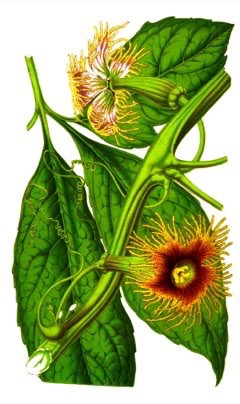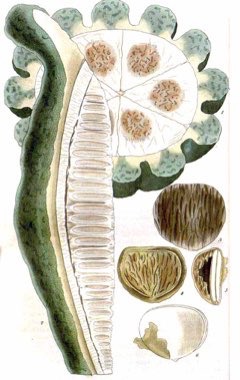 |
|
http://www.edibleplants.org |
 |
| http://www.edibleplants.org |
Translate this page:
Summary
Telfairia pedata, otherwise known as Oysternut, Queen?s Nut, or Zanzibar Oilvine, is a dioecious, fast-growing, evergreen vine about 30 m or more long. The leaves are smooth and alternate. Flowers are purple and seeds are flat and round. Oysternut is native to Tanzania and northern Mozambique but presently cultivated in other parts of Africa for its edible fruits, seeds, and seed oil. The oil is also useful for manufacturing soap, cosmetics, and candles, and for medicinal purposes. In particular, it is used as treatment for stomach problems and rheumatism.
Physical Characteristics

 Telfairia pedata is an evergreen Climber growing to 20 m (65ft) by 1 m (3ft 3in) at a fast rate.
Telfairia pedata is an evergreen Climber growing to 20 m (65ft) by 1 m (3ft 3in) at a fast rate.
See above for USDA hardiness. It is hardy to UK zone 10. The flowers are pollinated by Insects. The plant is not self-fertile.
Suitable for: light (sandy), medium (loamy) and heavy (clay) soils and prefers well-drained soil. Suitable pH: mildly acid and neutral soils and can grow in very acid soils.
It can grow in semi-shade (light woodland) or no shade. It prefers moist soil and can tolerate drought.
UK Hardiness Map
US Hardiness Map
Synonyms
Fevillea pedata Sims
Plant Habitats
Edible Uses
Edible Parts: Oil Seed
Edible Uses: Oil
Seed - raw or cooked[299 ]. A soft but firm texture with an excellent flavour[63 ]. The seed can be used to replace almonds or brazil nuts in confectionery and are also used in a variety of food dishes by local people[63 ]. The seed is usually roasted[300 ]. The seed contains about 30% protein[300 ] and has a high oil content[63 ]. It is irregularly circular in shape, about 4cm in diameter and 12mm thick[63 ]. It is easily extracted from its shell[63 ]. Seeds can be stored in their shells for several years in good condition[63 ]. To remove the bitter principle, whole seeds can be soaked for 8 hours in 3 changes of water. To remove the kernel from the shell, the fibrous husk is first partly cut away, then the shell is cracked and opened using a knife[299 ]. An oil extracted from the seed has a pleasant, slightly sweet flavour[63 ]. It makes a good cooking oil[298 ]. The seed contains up to 61% oil[303 ]. It is important to remove the husk of the seed before extracting the oil since it contains an intensely bitter substance that could contaminate the oil[63 , 299 ].
References More on Edible Uses
Medicinal Uses
Plants For A Future can not take any responsibility for any adverse effects from the use of plants. Always seek advice from a professional before using a plant medicinally.
Antirheumatic Galactogogue Stomachic
The seeds are said to have valuable galactagogue properties and are in great demand amongst native mothers who consume them shortly after the birth of a child as a tonic in order to regain their strength and also to improve the flow of milk[63 , 299 ]. The oil obtained from the seed is used as medicine for stomach troubles and rheumatism[299 ].
References More on Medicinal Uses
The Bookshop: Edible Plant Books
Our Latest books on Perennial Plants For Food Forests and Permaculture Gardens in paperback or digital formats.

Edible Tropical Plants
Food Forest Plants for Hotter Conditions: 250+ Plants For Tropical Food Forests & Permaculture Gardens.
More

Edible Temperate Plants
Plants for Your Food Forest: 500 Plants for Temperate Food Forests & Permaculture Gardens.
More

More Books
PFAF have eight books available in paperback and digital formats. Browse the shop for more information.
Shop Now
Other Uses
Cosmetic Lighting Oil Polish Soap making
Agroforestry Uses: Oysternut is part of the rich agroforestry systems of Mount Meru and Mount Kilimanjaro in Tanzania, where it is grown in combination with coffee and banana[299 ]. Other Uses The oil extracted from the seed can be used to make soap, candles and cosmetics[46 , 63 , 299 ]. The fibrous husk of the seed is sometimes used for polishing native earthenware pots[63 ].
Special Uses
Carbon Farming Food Forest
References More on Other Uses
Cultivation details
Management: Standard Other Systems: Multistrata Regional Crop Staple Crop: Protein-oil
Oysternut grows best in lowland, humid tropical areas at elevations up to 1,000 metres[300 ]. It can be cultivated at elevations up to 1,800 metres, though yields start to fall the more the elevation increases above 1,000 metres. It grows best in areas where annual daytime temperatures are within the range 23 - 28°c, but can tolerate 14 - 38°c[418 ]. It prefers a mean annual rainfall in the range 1,500 - 2,000mm, but tolerates 1,200 - 2,500mm[418 ]. Succeeds in full sun and in light shade[418 ]. Tolerant of a wide range of well-drained soils[298 , 300 ], though a humus-rich, fertile soil gives the best yields[300 ]. Prefers a pH in the range 5.5 - 6, tolerating 5 - 7[418 ]. Plants produce a deep taproot and, once established, are very drought resistant[63 , 298 , 300 ]. Plants are often trained to grow into trees[300 ]. They greatly dislike exposure to strong or cold winds[63 ]. This species has high weed potential[298 ]. Young plants grow very quickly, producing stems up to 7 metres long in 6 months and 15 metres long in 18 months[299 ]. Flowering normally commences 15 - 18 months after planting out the young plants[303 ]. Female and male plants cannot be distinguished until they flower[299 ]. The fruit takes 5 - 6 months to ripen from flowering[303 ]. When fruits ripen they split open gradually. To attain full flavour, the seeds should be allowed to ripen in the fruit and be collected 7 - 10 days after the fruit begins to split[299 ]. The plant produces up to 30 gourds in its third year and can continue production for another 20 years[299 , 303 ]. Under good conditions, two harvests per year are possible, and flowers and fruits can be present at the same time[299 ]. Annual seed yields of 3 - 7 tonnes per hectare have been achieved[63 , 299 ]. The fruits burst when ripe, scattering the seeds[63 ]. Care must be taken when growing these plants to choose sufficiently large trees for them to grow into, since their weight, especially when bearing a crop of fruits, can be enormous[63 ]. A dioecious plant, both male and female forms must be grown if seed is required[63 ]. Generally 12 - 15 males per hectare are sufficient to fertilise a plantation of females[63 ]. There are reports that female plants can produce fruit and seed in the absence of a male plant by a process called apomixis[299 ].
Carbon Farming
-
Management: Standard
Plants grow to their standard height. Harvest fruit, seeds, or other products. Non-Destructive management systems.
-
Other Systems: Multistrata
Multistrata agroforests feature multiple layers of trees often with herbaceous perennials, annual crops, and livestock.
-
Regional Crop
These crops have been domesticated and cultivated regionally but have not been adopted elsewhere and are typically not traded globally, Examples in this broad category include perennial cottons and many nuts and staple fruits.
-
Staple Crop: Protein-oil
(16+ percent protein, 16+ percent oil). Annuals include soybeans, peanuts, sunflower seeds. Perennials include seeds, beans, nuts, and fruits such as almond, Brazil nut, pistachio, walnut, hazel, and safou.
References Carbon Farming Information and Carbon Sequestration Information
Temperature Converter
Type a value in the Celsius field to convert the value to Fahrenheit:
Fahrenheit:
The PFAF Bookshop
Plants For A Future have a number of books available in paperback and digital form. Book titles include Edible Plants, Edible Perennials, Edible Trees,Edible Shrubs, Woodland Gardening, and Temperate Food Forest Plants. Our new book is Food Forest Plants For Hotter Conditions (Tropical and Sub-Tropical).
Shop Now
Plant Propagation
Seed - it has a short viability and is best sown as soon as ripe. Repeated soaking and drying promotes germination[299 ]. The seed can be sown in situ or in containers[300 ]. The drip line of trees is a favoured site for planting in situ[299 ]. When grown in containers, sow 2 - 3 seeds in each container thinning to the strongest plant once they germinate. The seed usually germinates in 7 - 14 days[303 ]. Seedlings grow away quickly and are ready for planting out about 30 days after germinating[300 ]. Layering. Very easy[63 ]. Cuttings. Stemcuttings root in 2 - 3 weeks, and produce shoots 6 - 7 weeks after planting[299 ].
Other Names
If available other names are mentioned here
Chitando, Cungo, Fluted cucumber, Kweme, Matandu, Ng'eme, Nkungu, Zanzibar oil-vine, castanha de inhambane, castanha-de-inhambane, châtaigne de l'inhambane, cungo, cungua, dicungo, ikungu, ikweme, kouémé, kueme, kweme, liane de joliff, lipeme, makwene, meme, mkwema, mkweme, n'kungu, oyster nut, oysternut, queen's-nut, talerkürbis, tandu, umpeme, zanzibar oil vine, zanzibar oilvine.
Native Range
AFRICA: Tanzania (incl. Zanzibar Is. & Pemba Is.), Mozambique.
Weed Potential
Right plant wrong place. We are currently updating this section.
Please note that a plant may be invasive in one area but may not in your area so it's worth checking.
Conservation Status
IUCN Red List of Threatened Plants Status : This taxon has not yet been assessed

Growth: S = slow M = medium F = fast. Soil: L = light (sandy) M = medium H = heavy (clay). pH: A = acid N = neutral B = basic (alkaline). Shade: F = full shade S = semi-shade N = no shade. Moisture: D = dry M = Moist We = wet Wa = water.
Now available:
Food Forest Plants for Mediterranean Conditions
350+ Perennial Plants For Mediterranean and Drier Food Forests and Permaculture Gardens.
[Paperback and eBook]
This is the third in Plants For A Future's series of plant guides for food forests tailored to
specific climate zones. Following volumes on temperate and tropical ecosystems, this book focuses
on species suited to Mediterranean conditions—regions with hot, dry summers and cool, wet winters,
often facing the added challenge of climate change.
Read More
Expert comment
Author
(Sm. ex Sims) Hook.
Botanical References
Links / References
For a list of references used on this page please go here
A special thanks to Ken Fern for some of the information used on this page.
Readers comment
| Add a comment |
|
If you have important information about this plant that may help other users please add a comment or link below. Only comments or links that are felt to be directly relevant to a plant will be included. If you think a comment/link or information contained on this page is inaccurate or misleading we would welcome your feedback at [email protected]. If you have questions about a plant please use the Forum on this website as we do not have the resources to answer questions ourselves.
* Please note: the comments by website users are not necessarily those held by PFAF and may give misleading or inaccurate information.
To leave a comment please Register or login here All comments need to be approved so will not appear immediately.
|
Subject : Telfairia pedata
|
|
|
|